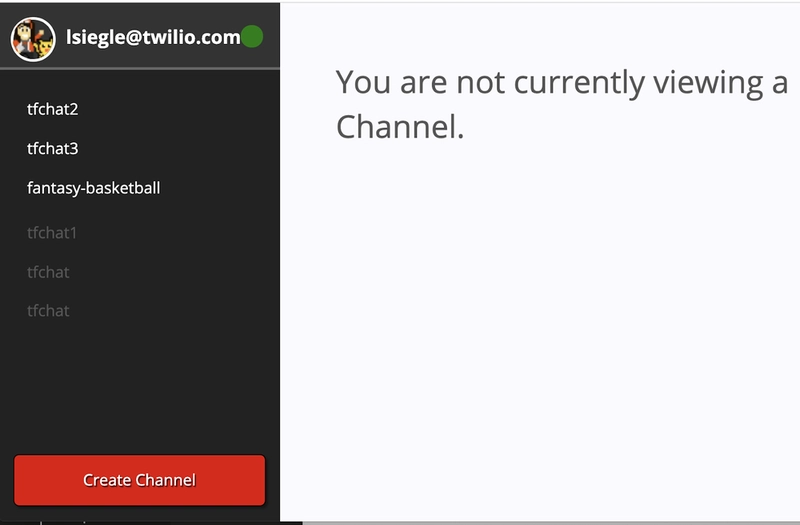使用 Tensorflow.js 检测 Twilio 聊天中的恶意语言
这篇博客文章是为Twilio撰写的,最初发表在 Twilio 博客上。
在当今的网络交流环境中,粗鲁或冒犯性的评论可能泛滥;然而,借助机器学习的力量,我们可以开始打击这种现象。
这篇博文将展示如何使用预先训练的 TensorFlow 模型和TensorFlow.js在客户端将文本分类为淫秽或有毒内容。然后,我们将此分类应用于使用Twilio 可编程聊天在聊天室中发送的消息。
Google 提供了许多预训练的 TensorFlow 模型,可供我们在应用程序中使用。其中一个模型是在Kaggle上提供的维基百科评论标注数据集上训练的。Google 提供了一个预训练的 TensorFlow.js 毒性模型的现场演示, 您可以在其中测试短语。 在继续阅读之前,您还可以 在 Twilio 博客上阅读《开始使用 TensorFlow 之前你需要知道的 10 件事》。
设置
- 在开始之前,首先需要使用以下命令克隆Twilio JavaScript 聊天演示存储库
git clone https://github.com/twilio/twilio-chat-demo-js.git - 确保您拥有Twilio 帐户 ,以便获取帐户 SID、API 密钥 SID 和密码,以及您可以在Twilio 控制台聊天仪表板中创建的聊天服务 SID
- 在命令行上,确保您位于刚刚克隆的项目目录中
cd twilio-chat-demo-js
# make a new file credentials.json, copying it from credentials.example.json, and replace the credentials in it with the ones you gathered from your account in step one
cp credentials.example.json credentials.json
# install dependencies
npm install
# then start the server
npm start
现在,如果您访问http://localhost:8080, 就可以测试一个基本的聊天应用程序了! 您可以使用您选择的用户名或 Google 帐户以访客身份登录。请务必创建一个通道,以便使用 Tensorflow.js 检测潜在的恶意消息!
将 Tensorflow.js 集成到 Twilio 可编程聊天中
打开/public/index.html并在标签之间的某个位置<head></head>,使用以下行添加 TensorFlow.js 和 TensorFlow Toxicity 模型:
<script src="https://cdn.jsdelivr.net/npm/@tensorflow/tfjs"></script>
<script src="https://cdn.jsdelivr.net/npm/@tensorflow-models/toxicity"></script>
这使得“toxicity”成为一个可以在 JavaScript 代码中使用的全局变量。好了!您已安装模型。
typing-indicator 在div上方的同一 HTML 文件中, 添加以下行,如果聊天消息被视为冒犯,则会显示警告文本。
<div id="toxicity-indicator"><span></span></div>
在其正下方,对其进行以下样式更新div。
<style>
#channel-messages {
margin-bottom: 100px;
position: relative;
width: 100%;
height: calc(100%- 100px);
overflow-y: auto;
}
#toxicity-indicator {
padding: 5px 15px;
font-weight: bold;
color: #E30000;
}
#toxicity-indicator span {
display: block;
min-height:
18px;
}
</style>
现在打开/public/js/index.js并准备做很多事情。 首先,我们将创建一个名为 的函数,用于检索聊天输入有害可能性的预测。它接受两个参数:“input”和“model”。classifyToxicity
function classifyToxicity(input, model) {
我们需要classify()在模型上调用方法来预测输入聊天消息的恶意程度。此方法调用返回一个以 为解析条件的 Promise predictions。
console.log("input ", input);
return model.classify(input).then(predictions => {
predictions是一个包含每个标签概率的对象数组。TensorFlow 模型可以根据标签进行预测:identity_attack、、、、、和。接下来insult,我们将循环遍历该数组,解析每个标签的三个值:标签,它是真 (匹配的概率大于阈值)、假 (不匹配的概率大于阈值)还是obscene空(severe_toxicity两者都不大于) ,以及预测(模型对输入为真、假或空的置信度百分比)。sexual_explicitthreattoxicity
return predictions.map(p => {
const label = p.label;
const match = p.results[0].match;
const prediction = p.results[0].probabilities[1];
console.log(label + ': ' + match + '(' + prediction + ')');
return match != false && prediction > 0.5;
}).some(label => label);
});
在上面的代码中,一个条件判断函数会检查模型对 TensorFlow 模型能够预测的七个有毒标签的置信度是否超过 50%,即输入内容为有毒内容。如果任何一个标签的预测结果为正值,则返回 true。完整的classifyToxicity()函数如下所示:
function classifyToxicity(input, model) {
console.log('input ', input);
return model.classify(input).then(predictions => {
return predictions.map(p => {
const label = p.label;
const match = p.results[0].match;
const prediction = p.results[0].probabilities[1];
console.log(label + ': ' + match + '(' + prediction + ')');
return match != false && prediction > 0.5;
}).some(label => label);
});
现在,每当聊天中有人输入新消息时,我们都需要调用此函数。 接下来,我们将加载模型,并接受一个可选参数。默认值为 0.85,但在本文中,为了更精确,我们将其设置为常数 0.9。给定输入(在本例中为聊天消息),标签是您要预测的输出,阈值是模型对 TensorFlow 模型所提供预测的七个“有毒”标签的置信度。toxicity.load()threshold
理论上,阈值越高,准确率就越高;然而,较高的阈值也意味着预测结果更有可能返回null, 因为它们低于阈值。您可以随意尝试更改阈值,看看这会如何改变模型返回的预测结果。
搜索$('#send-message').on('click', function () {并在该行上方添加
$('#send-message').off('click');
const threshold = 0.9;
toxicity.load(threshold).then(model => {
$('#send-message').on('click', function () {
toxicity.load返回一个已解析模型的 Promise。加载模型也意味着加载其拓扑和权重。
拓扑:描述模型架构(使用的操作)的文件,包含对存储在外部的模型权重的引用。
权重:包含模型权重的二进制文件,通常与拓扑存储在同一目录中。
(参考TensorFlow 模型保存和加载指南)
您可以在 TensorFlow 文档、Keras 文档中阅读有关拓扑和权重的更多信息,还有许多研究论文对它们进行了详细的介绍。
现在,我们将向处理用户尝试发送消息的函数添加一些额外的代码。在中间$('#send-message').on('click', function () {添加var body = $('#message-body-input').val();
$('#toxicity-indicator span').text('');
如果我们设置了警告消息,这将清除它。接下来,在send-message点击事件中,我们使用函数检查消息 classifyToxicity。如果解析结果为 true,则不会发送消息并显示警告。 完整代码如下:
toxicity.load(threshold).then(model => {
$('#send-message').on('click', function () {
$('#toxicity-indicator span').text('');
var body = $('#message-body-input').val();
classifyToxicity(body, model).then(result => {
if (result) {
$('#toxicity-indicator span').text('This message was deemed to be toxic, please be more kind when chatting in this channel.');
$('#message-body-input').focus();
} else {
channel.sendMessage(body).then(function () {
$('#message-body-input').val('').focus();
$('#channel-messages').scrollTop($('#channel-messages ul').height());
$('#channel-messages li.last-read').removeClass('last-read');
});
}
});
});
});
让我们保存文件,确保npm start它从命令行运行,然后在localhost:8080上测试聊天! 您会看到应用程序检测到恶意语言并显示警报。对于更友好的用户输入,您不会收到警告消息,但您可以通过查看 JavaScript 控制台来查看概率,如下所示: 根据您的阈值,“我爱你,你真好”之类的消息的概率可能如下所示

下一步是什么?
这款 TensorFlow 模型还有其他用例:您可以执行情绪分析、审查消息、发送其他警告等等!您也可以在Twilio SMS 或其他消息平台上尝试此功能。根据您的用例,您还可以尝试不同的恶意标签。敬请关注更多 TensorFlow 与 Twilio 结合使用的帖子!请在评论区或在线告诉我您正在构建什么。GitHub
:elizabethsiegle
Twitter:@lizziepika
电子邮件:lsiegle@twilio.com
 后端开发教程 - Java、Spring Boot 实战 - msg200.com
后端开发教程 - Java、Spring Boot 实战 - msg200.com




